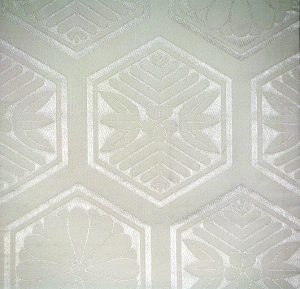Description
The intricate pattern of the hand weaving make this a splendid accessory in any neutral setting.
This is a rare, hand woven Silk “Maru Obi,” which is the most formal and most expensive of the Japanese Obi. A Maru Obi has but one seam, and has been woven in a continuous repeat pattern and folded over to create 2 visions of the same dramatic scene. This is a very lustrous, fine Silk Obi with a wonderful sheen that, when turned in different directions and in a different light, will appear to change color. This is a sign of a very high quality Obi. The colors are from natural dyes and are the more traditional colors of ancient Japan, while the high sheen of the Silk adds immeasurably to its value.
This is a typical “Meiji jimon” pattern, meaning that it is a motif that is repeated over and over again to create a striking design. The two variations of the Pine (“Matsu”) and the Bamboo (“Take”) create horizontal bands of design in natural colors of beige and black on a greige background, creating one of nature’s changing colors or the seasons. The monotones indicate that a married woman wore this exquisitely-woven Obi.
The Bamboo is versatile, graceful and auspicious, and has played an extraordinarily large role in Japan from ancient times. It is revered for its strength and flexibility. The Japanese word for Bamboo (“Take”) is homophonous with Chinese characters used in words for warrior and bravery and sounds like the words for tall (takai) and hawk (taka). Thus it is very likely that this subtle, but very fine, Obi belonged to a woman of Samurai rank. The Pine has also been honored. It is considered a tree of long life and good fortune…an auspicious sign of longevity, symbolizing a thousand years of life. It is resistant to the wind, resilient beneath the snow, and a fitting partner for the Bamboo in this Obi pattern. The two versions of the Pine, the crossed pine and pine boughs indicate an emotional involvement with plants and nature; while the intricacy of the design and the unusual coloring attest to the artistry of the weaver. The pure Gold stripes at the bottom of the pattern denote that a woman of high rank and wealth in Japanese society wore this dramatic Obi.
A Certificate of Authenticity is included.
TTAC will personally pack and ship via UPS at company expense within the continental U.S.








